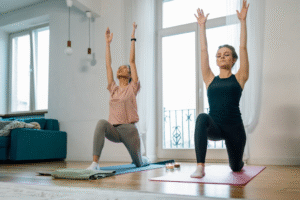Walking for fitness and weight loss offers a simple, effective, and beginner-friendly solution to improve your health and drop those extra pounds. This accessible exercise requires no gym membership, expensive gear, or previous experience—just a willingness to move. Perfect for busy professionals, parents, or anyone new to fitness, walking is a low-impact activity that seamlessly blends into any schedule. In this beginner’s guide, we’ll uncover how walking can revolutionize your well-being, support weight loss, and pave the way for lasting vitality. By the end, you’ll have the knowledge and inspiration to slip on your shoes and embark on your journey to a fitter, healthier you.
Walking isn’t just about burning calories; it’s about building a sustainable habit supporting your physical and mental well-being. Studies show that regular walking can reduce body fat, improve cardiovascular health, and even boost your mood. For beginners, the beauty of walking for fitness and weight loss lies in its simplicity—it’s an exercise you already know how to do, and it can be tailored to your pace and goals. Let’s dive into how walking works, why it’s effective, and how you can make it a cornerstone of your fitness routine.
Table of Contents
>>> Get More Views On YouTube Fast
1. Why Walking Works for Weight Loss and Fitness

Walking for fitness and weight loss is more than just a stroll—it’s a scientifically backed method to burn calories and improve overall health. The key to weight loss is creating a calorie deficit, meaning you burn more calories than you consume. Walking helps you achieve this without the intensity of high-impact workouts like running or weightlifting, making it ideal for beginners. On average, a 150-pound person burns about 100 calories per mile walked at a moderate pace (3-4 mph). Increase your speed or distance, and that number climbs even higher.
Beyond calorie burning, walking strengthens your heart, improves circulation, and boosts metabolism. It’s a full-body exercise that engages your legs, core, and even arms if you swing them purposefully. For beginners, the low-impact nature of walking reduces the risk of injury while still delivering measurable results. Plus, it’s free and can be done anywhere—your neighborhood, a park, or even a treadmill. The accessibility of walking for fitness and weight loss makes it a powerful tool for anyone looking to kickstart their journey.
2. How to Start Walking for Fitness and Weight Loss
Getting started with walking for fitness and weight loss doesn’t require a complicated plan—just a pair of comfortable shoes and a little determination. As a beginner, aim for 20-30 minutes of brisk walking 3-5 times a week. A brisk pace means you’re moving fast enough to raise your heart rate and feel slightly out of breath, but you can still hold a conversation. This aligns with the American Heart Association’s recommendation of at least 150 minutes of moderate aerobic activity per week for overall health.
Start by setting realistic goals. For example, walk for 10 minutes a day and gradually increase your time or distance as your stamina improves. Track your progress with a fitness app or a simple notebook to stay motivated. To maximize weight loss, consistency is key—make walking a daily habit, like brushing your teeth. You can also mix it up by choosing different routes or adding inclines to challenge yourself. The beauty of walking for fitness and weight loss is its flexibility; it adapts to your schedule and fitness level.
>>>>Click Here To Create Your First $1,000 Short AI
3. Tips to Maximize Results from Walking
While walking alone can kickstart your fitness and weight loss journey, a few tweaks can amplify your results. First, focus on posture—stand tall, engage your core, and swing your arms naturally to burn more calories and tone your muscles. Second, increase intensity over time. Once you’re comfortable with a brisk pace, try interval walking: alternate between 1-2 minutes of fast walking and 1-2 minutes of a slower pace. This boosts your metabolism and burns fat more efficiently.
Another tip is to pair walking for fitness and weight loss with a balanced diet. Exercise alone won’t shed pounds if your calorie intake exceeds what you burn. Incorporate whole foods like vegetables, lean proteins, and healthy fats to support your goals. Hydration matters too—drink water before and after your walks to keep your energy up. Finally, consider walking with a friend or listening to music or podcasts to make it enjoyable. The more you look forward to your walks, the more likely you are to stick with them.
>>>Click Here To Create Eye-Catching Thumbnails & Titles In Second
4. Overcoming Common Challenges for Beginners
Starting any new habit comes with hurdles, and walking for fitness and weight loss is no exception. One common challenge is finding time. If your day feels packed, break your walks into shorter sessions—two 15-minute walks can be just as effective as one 30-minute session. Weather can also be a barrier, but indoor options like malls, staircases, or treadmills keep you on track. Invest in a good pair of walking shoes to avoid blisters or discomfort, especially as you increase your mileage.
Motivation can wane, too, especially if results don’t show immediately. Weight loss takes time, and walking builds gradual, sustainable progress rather than quick fixes. Celebrate small wins, like feeling more energetic or walking a longer distance, to stay encouraged. If boredom sets in, change your scenery or challenge yourself with a step goal (10,000 steps a day is a popular target). By anticipating and addressing these challenges, walking for fitness and weight loss becomes a seamless part of your routine.
>>>Click Here To Create Eye-Catching Thumbnails & Titles In Second
Conclusion
Walking for fitness and weight loss is a beginner-friendly, effective, and enjoyable way to transform your health and reach your goals. It’s not about speed or distance at first—it’s about taking that initial step and building a habit you can sustain. From burning calories and boosting your heart health to improving your mood and energy, walking offers benefits that go beyond the scale. With the tips and strategies in this guide, you’re equipped to start your journey and see real results.




